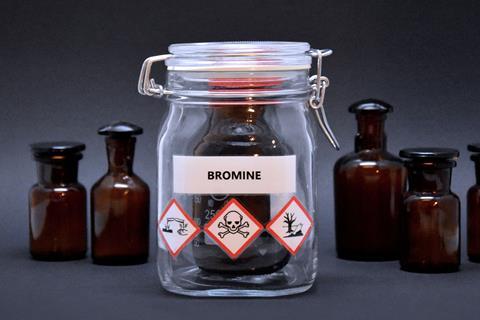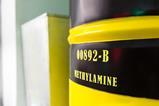A journey that begins in a former oil field in Arkansas

Suzuki reactions are dead simple – the palladium-catalysed coupling of aryl bromides or aryl iodides with aromatic boronic acids. I always wonder who makes these chemicals, and where they get their raw materials from. While the answers for carbon-based molecules are almost always simple – the petroleum industry – I am curious about the other atoms. Where did the bromine or the iodine come from? Is there a big pile of boron somewhere? (This one’s easy – there’s a town called Boron in California with the largest borax mine in the world.)
The only commercial source of bromine in the United States is found in the woods of southern Arkansas in the Smackover Formation, a geologic formation stemming from the Jurassic period. It was a successful oil field for many years, and then chemists in the 1950s discovered that the brine often found there contained 4000–4600 parts per million (ppm) bromide, quite a bit higher than the level of bromine found in typical ocean water. The bromine production plants followed shortly thereafter. (Prior to the discovery of the bromine, the unwanted brine was disposed of by dumping it into a local river! Now, the spent brine is injected back into the formation.)
Bromine production is surprisingly simple in theory. Chlorine gas acts as an oxidant when combined with hot concentrated brine solutions, releasing chloride ions and bromine which is subsequently recovered and purified. As simple as that description is, the plants are very complex and large (one in Israel is 180 hectares!). Handling bromine on industrial scale requires many unusual materials, including glass (a somewhat unusual choice in a production environment) and tantalum (somewhat common in production environments, but very expensive and difficult to machine.)
The redox process used to transform bromide to bromine is useful for producing iodine as well. Not too far from southern Arkansas is yet another geologic formation, this time in northwestern Oklahoma. The Woodward Trench contains brine that is rich in iodide (300ppm) and that is used to produce iodine. In this case, the iodide-rich brine is combined with chlorine gas to oxidise the iodide to iodine. The iodine is then vaporised or ‘blown out’ and recovered by reaction with sulfur dioxide to transform it to hydroiodic acid. This is then reacted again with chlorine to produce pure iodine, which can be packaged as either flakes or little balls (prills) in drums.
A lot of bottle
That’s not so simple for packaging and transporting bromine, which is a liquid (and one with a high vapor pressure!) How does it get to your facility? If you’re a laboratory chemist, you’re familiar with the classic amber glass bottle. That’s a very convenient way to get your bromine. With its 3.1 grams per millilitre density, even a one litre bottle will deliver plenty of bromine for your reactions. These bottles find their way into the plant now and again. A purchasing manager in a pinch might deliver 50 or 100 500g bottles, but that is a great way to annoy the chemical operators who will have to uncap these bottles one at a time, carefully pour them into the reactor and not drop them.
What if you need 400kg of bromine? Well, you will get shipped a bromine ‘drum’ – but it will look unlike any drum that you have seen. It resembles an unusually large fire hydrant or a steel pipe, with lots of bolts and a very large slot where the forklift tines will be used to transport it. (There’s no chance of you using a dolly to move this ‘drum’ around, as its gross weight is over 800kg!) Once you lift the very sturdy lid, you will be able to access the valves that are pretty typical for any large chemical cylinder.
If you need even more bromine, you could order a very large isotank, which looks like a large chemical tank. It has an 8000 litre volume – and to preserve the steel lining, a layer of lead resists the bromine’s corrosive power. This monster container can bring you 23,000kg of bromine.
The bulk of the world’s bromine is used for brominated fire retardants; the use of the world’s iodine is more diffuse. I don’t think the Dead Sea is going to run out of bromide any time soon, nor are people predicting the end of iodine production in Oklahoma. That being said, I do wonder if there will be a time when it will make economic sense to extract elements out of the waste products in chemical industry. The bromine that goes to make that aryl bromide for the Suzuki reaction will eventually be bromide in solution once again, and it will be there for the innovative chemist who can determine a useful and practical way to recover it.

















1 Reader's comment